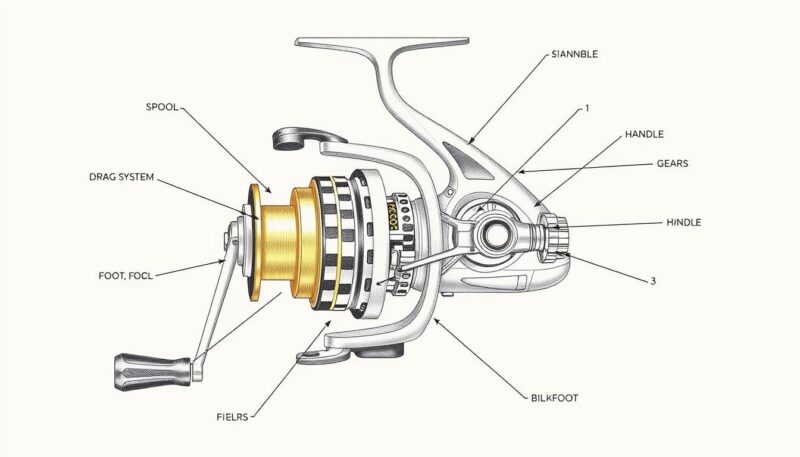Understanding the parts of a fishing reel is essential for anyone looking to enhance their angling skills. Whether you’re a novice just starting your fishing journey or a seasoned pro looking to refine your technique, knowing how these fishing reel parts work together can significantly impact your success on the water. Each component in a fishing reel serves a unique and vital function, contributing to the overall performance. From the reel body to the drag system, these fishing reel components work harmoniously to ensure optimal operation during your fishing adventures. In this article, you’ll gain insights into the design and functionality of various reel parts, empowering you with the knowledge to make informed choices about your fishing gear.
With various types of reels available, such as spinning and baitcasting, it’s crucial to grasp the distinctions between their components. Spinning reels typically consist of seven essential parts, including the spool, bail, and handle, while baitcasting reels usually feature six components, such as the spool and brake system. As you dive into the intricacies of how a fishing reel works, you’ll find that a thorough understanding of these parts not only bolsters your effectiveness in fishing but also allows for better gear maintenance and improvements in fishing techniques.
Understanding Fishing Reel Components
A comprehensive understanding of fishing reel components enhances your fishing experience significantly. Familiarity with these parts will not only improve your ability to choose the right reel but will also aid in effective fishing reel maintenance and usage.
Reel Body
The reel body serves as the essential housing for all internal components, ensuring durability and stability during use. Depending on the model, you might find either aluminum or graphite as the primary material. Aluminum offers strength but is heavier, while graphite is lighter and resists corrosion, particularly in saltwater contexts. The choice between these materials can influence your overall fishing reel features and adaptability to various conditions.
Handle
A well-designed handle is vital for retrieving line effectively. The ergonomic shape impacts how comfortable and responsive the handle feels in your hand. Length and weight play significant roles—shorter handles can offer quick response times suited for bass fishing, whereas longer handles provide stability and comfort for bigger catches. Additionally, many spinning reels feature reversible handles, accommodating both left-handed and right-handed anglers, thus broadening their usability.
Spool
The spool’s role is crucial, as it holds the fishing line and directly influences casting distance and precision. Spool capacity varies, with sizes typically accommodating 100 to 300 yards of fishing line. Certain spools also come equipped with ‘Braid Ready’ features, allowing braided line attachment without needing a monofilament backing, improving practicality for avid anglers. It’s important to check the specifications to avoid tangles, which can arise from improper line management.
Gear Mechanism
The gear mechanism is fundamental for smooth line movement during retrieval. This component is characterized by various fishing reel gear ratios, affecting performance and speed. High-end models often employ brass or aluminum gears, balancing strength and weight for optimal efficiency. Regular maintenance of this mechanism is essential for preventing wear and maintaining its functionality over time.
Drag System
The drag system regulates the tension of the line during a catch, making it vital for successful fish fighting. A smooth drag system can prevent line breakage by allowing fish to pull line when necessary. Adjustments are typically located on the top of the spool or at the back of the reel body, allowing quick and easy modifications while you are actively fishing. Proper understanding and maintenance of this system can result in significantly improved outcomes during your fishing trips.
Parts of a Fishing Reel Explained
Understanding the intricate parts of a fishing reel is essential for every angler looking to enhance their fishing experience. Each component plays a crucial role in the overall functionality of the reel, making it important to familiarize yourself with what they do and how they interact with one another. Below are detailed descriptions of some vital components.
Drag Adjustment
The drag system on a reel allows you to customize the tension on the line, adapting to the fish you are targeting. By adjusting the drag, you can manage how much line is released when a fish pulls on it, critical for maintaining control during a catch. This feature is often located on top of the spool or at the rear of the reel body.
Bail and Line Roller
The bail acts as a gate for the line, serving a dual purpose. It opens to allow the line to spool off during casting and closes to retrieve the line. Ensuring the bail operates smoothly is essential, as any dysfunction may lead to line tangles. The line roller assists in managing line flow during retrieval, providing even pressure throughout the process.
Line Guide
The spool and line guide ensure that the line remains evenly distributed as you reel in. This feature is essential for casting accuracy and prevents line twisting and tangling. By guiding the line directly onto the spool, the line guide promotes an effective and efficient fishing experience.
Reel Foot and Housing
The reel foot serves as the connection point between the fishing reel and the rod, providing stability and structural integrity. The housing, typically made from materials like aluminum or graphite, encases all components, protecting them from wear and damage. For anglers, a sturdy reel housing means less worry about breakage during use.
Anti-Reverse Switch and Bearings
The anti-reverse switch prevents backward reel movement, crucial for enhancing your ability to set hooks effectively. Inside the reel, precision bearings allow for smooth operation, ensuring all moving parts respond fluidly during use. Regular fishing reel cleaning will help maintain optimal performance, as dirt and debris can affect these components significantly.

Conclusion
Understanding the different parts of a fishing reel is essential for both novice and experienced anglers alike. Whether you’re using spinning reels for a wide range of conditions or opting for baitcasting reels to enhance your accuracy, knowing the specific components can significantly impact your fishing success. Familiarizing yourself with fishing reel types allows you to select the right gear tailored to your needs and fishing environment.
Equally important is the knowledge of fishing reel maintenance, which can extend the life of your equipment by 20-30% with regular care. Learning how to repair a fishing reel not only empowers you to troubleshoot issues but also enhances your gear’s performance. With proper attention, you can enjoy your time on the water without worrying about tangles or mechanical failures, allowing for a more enjoyable fishing experience.
From spincasting reels ideal for beginners due to their ease of use, to specialized trolling reels designed for deep-sea adventures, choosing the right fishing reel type tailored to your fishing style makes all the difference. By integrating good maintenance practices into your routine, you can ensure that your fishing tackle remains in top shape for seasons to come, elevating your overall angling experience.

